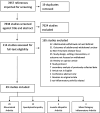Approaches and outcomes of adalimumab discontinuation in patients with well-controlled inflammatory arthritis: a systematic search and review
- PMID: 39734203
- PMCID: PMC11684048
- DOI: 10.1186/s12969-024-01046-3
Approaches and outcomes of adalimumab discontinuation in patients with well-controlled inflammatory arthritis: a systematic search and review
Abstract
Objective: This systematic search and review aimed to evaluate the available literature on discontinuation of adalimumab and other tumor necrosis factor inhibitors (TNFi) for patients with well-controlled chronic inflammatory arthritides.
Methods: We conducted a publication search on adalimumab discontinuation from 2000-2023 using PubMed, CINAHL, EMBASE, and Cochrane Library. Included studies evaluated adalimumab discontinuation approaches, tapering schemes, and outcomes including successful discontinuation and recapture after flare, in patients with well-controlled disease. Studies included evaluated rheumatoid arthritis, ankylosing spondylitis, psoriatic arthritis, and juvenile idiopathic arthritis (JIA).
Results: Forty-nine studies were included. Studies evaluating adalimumab alone were limited, and many reported TNFi outcomes as a single entity. Studies on rheumatoid arthritis (RA) (32, 8 RCTs) reported flare rates from 33-87%. Flares with medication tapering were slightly lower than with abrupt stop, and successful recapture was generally high (80-100%). Studies on spondyloarthropathy (12, 4 RCTs), focused on tapering, noting lower flare rates in tapering rather than abruptly stopping, and high recapture rates (~ 90%). Studies on JIA (5) were observational and demonstrated modestly lower flare rates with tapering (17-63%) versus abrupt stopping (28-82%). There was notable variability in study design, follow-up duration, specificity for TNFi results, and controlled pediatric studies.
Conclusion: The literature evaluating adalimumab and other TNFi discontinuation, flare rates, and recapture success within the inflammatory arthritis population demonstrated less flare when medications were tapered, over abrupt stop in the RA, spondyloarthropathy, and JIA populations. When medications were restarted after flare, recapture of well-controlled disease was generally high in RA and spondyloarthropathy, and generally favorable in JIA.
Keywords: Adalimumab; Juvenile idiopathic arthritis; Medication discontinuation; Rheumatoid arthritis; Spondyloarthritis.
© 2024. The Author(s).
Conflict of interest statement
Declarations. Ethics approval and consent to participate: This manuscript has been reviewed and approved by all contributing authors; all work is original. This work did not require IRB approval. Consent for publication: Not applicable. Competing interests: DBH received research funding and salary support from the Childhood Arthritis and Rheumatology Research Alliance. All remaining authors involved in this manuscript have no other conflicts of interest related to this work to disclose.
Figures
References
-
- Lovell DJ, Johnson AL, Huang B, Gottlieb BS, Morris PW, Kimura Y, et al. Risk, timing, and predictors of disease flare after discontinuation of anti-tumor necrosis factor therapy in children with polyarticular forms of juvenile idiopathic arthritis with clinically inactive disease. Arthritis Rheumatol. 2018;70(9):1508–18. - PMC - PubMed
-
- Aga AB, Lie E, Uhlig T, Olsen IC, Wierød A, Kalstad S, et al. Time trends in disease activity, response and remission rates in rheumatoid arthritis during the past decade: results from the NOR-DMARD study 2000–2010. Ann Rheum Dis. 2015;74(2):381–8. - PubMed
Publication types
MeSH terms
Substances
Grants and funding
LinkOut - more resources
Full Text Sources
Research Materials


